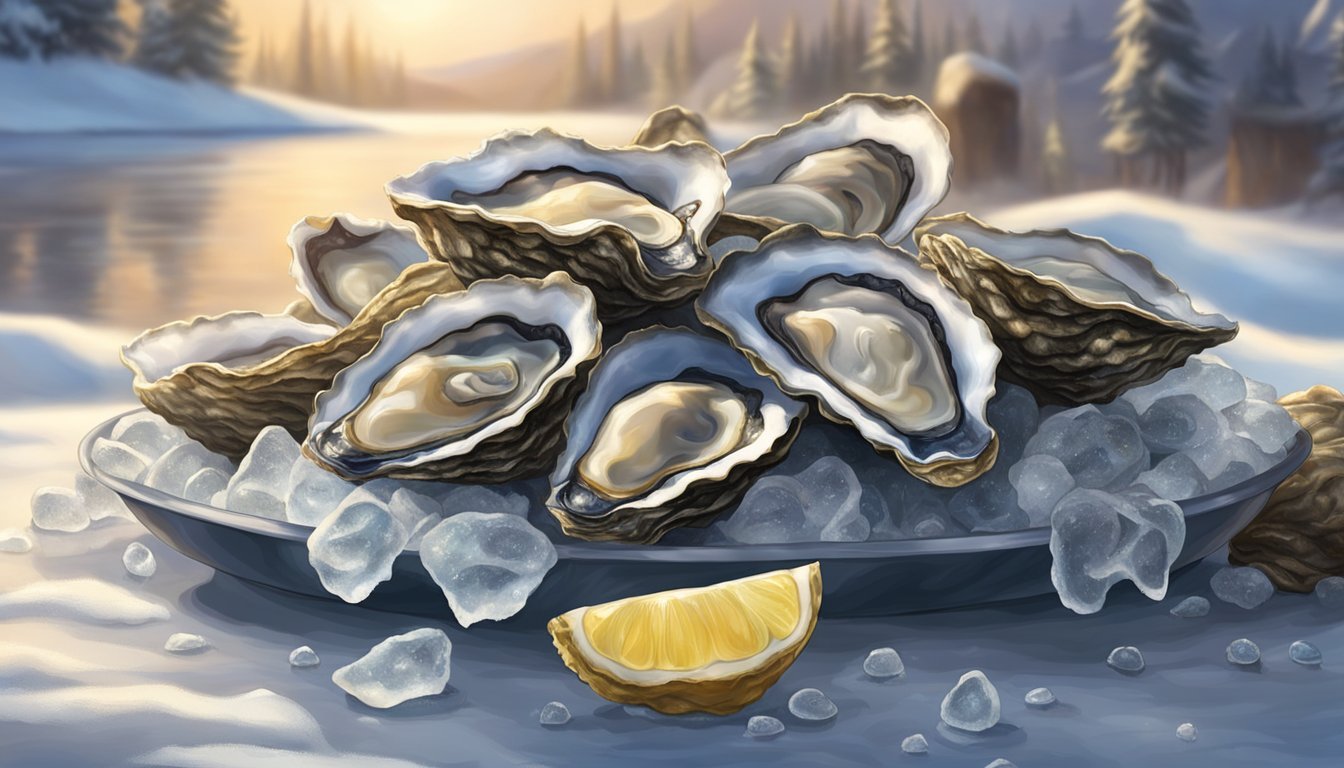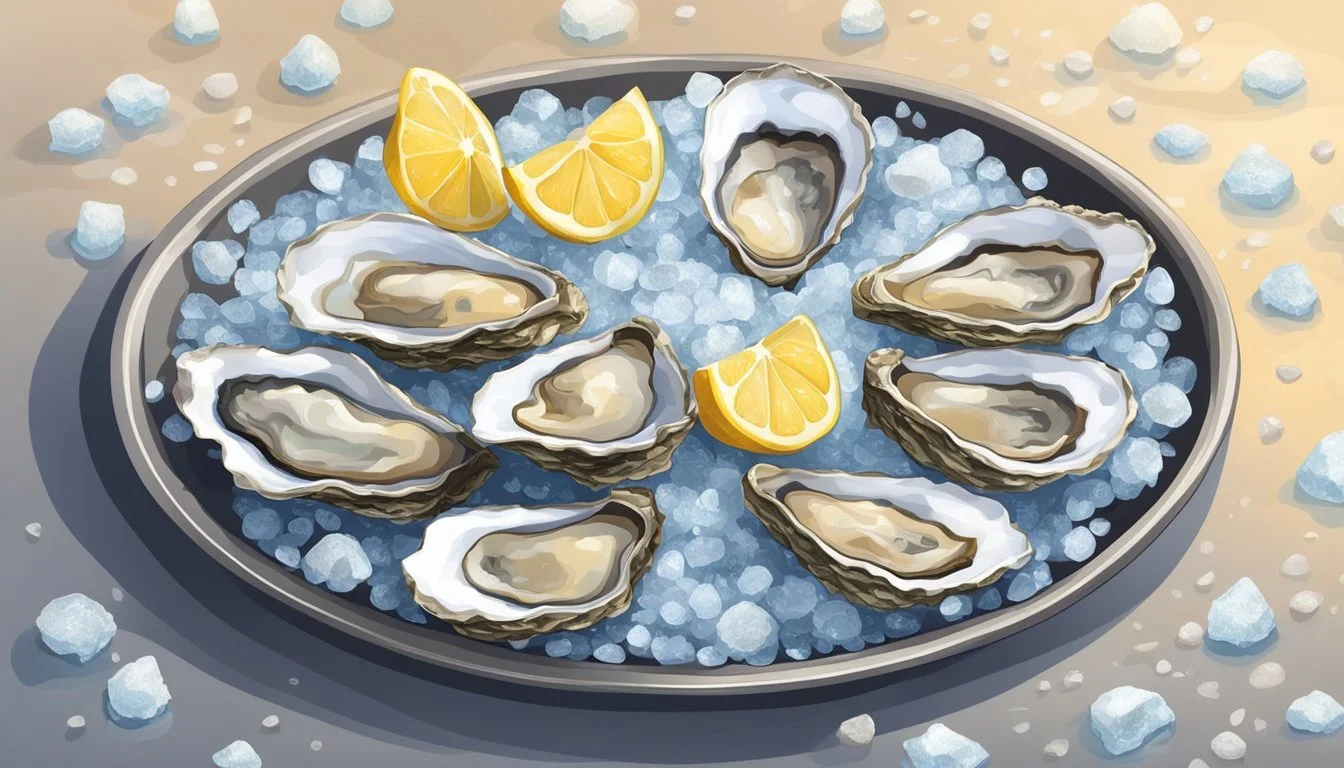Fresh vs Frozen Oysters: Comparing Taste, Texture, and Safety
Oysters are a beloved delicacy enjoyed by seafood enthusiasts around the world. The debate between fresh and frozen oysters has long been a topic of discussion among chefs and consumers alike. Both fresh and frozen oysters can offer high-quality seafood experiences when handled properly, with each option having its own advantages.
Fresh oysters are prized for their briny flavor and delicate texture straight from the shell. They provide an unparalleled dining experience for those seeking the essence of the sea. Frozen oysters, on the other hand, offer convenience and extended shelf life without significantly compromising on taste or nutritional value. Modern freezing techniques preserve the oysters' quality, making them a viable alternative when fresh options are unavailable.
Choosing between fresh and frozen oysters ultimately depends on factors such as availability, intended use, and personal preference. Fresh oysters shine in raw preparations, while frozen oysters excel in cooked dishes. Both types can deliver the rich, mineral flavors and tender texture that oyster lovers crave, ensuring a satisfying seafood experience regardless of the chosen form.
Understanding Oysters
Oysters are fascinating bivalve mollusks prized for their unique flavor and texture. These shellfish have been harvested and consumed for centuries, with various species found in coastal waters worldwide.
Anatomy of an Oyster
An oyster's body is protected by two hard, calcium carbonate shells connected by a hinge. Inside, the soft body consists of gills, a heart, and digestive organs. The adductor muscle controls shell opening and closing.
Oysters have a mantle that secretes nacre, forming the inner shell layer. This same process creates pearls when irritants enter the shell.
The oyster's reproductive organs can change between male and female, allowing them to adapt to environmental conditions.
Varieties of Oysters
Oysters come in numerous species and regional varieties, each with distinct characteristics. Popular types include:
Pacific oysters: Large, sweet, and creamy
Kumamoto oysters: Small, with a nutty flavor
Atlantic oysters: Briny and mineral-rich
European flat oysters: Intense, metallic taste
Regional factors like water temperature, salinity, and algae influence oyster flavor profiles. This creates unique "merroir" similar to wine terroir.
Some well-known oyster regions include Chesapeake Bay, Puget Sound, and Brittany, France.
Oysters as Seafood
Oysters are a versatile and nutritious seafood option. They're low in calories but high in zinc, iron, and vitamin B12. Oysters can be enjoyed raw, grilled, fried, or baked.
Raw oysters are often served on the half-shell with lemon or mignonette sauce. Cooked preparations include Oysters Rockefeller and oyster stew.
When selecting oysters, look for tightly closed shells and a fresh, briny smell. Fresh oysters should be consumed within a few days of purchase.
Oysters play a crucial role in marine ecosystems by filtering water and providing habitat for other species. Sustainable oyster farming helps maintain wild populations and improve water quality.
Fresh Oysters
Fresh oysters offer a unique culinary experience with their briny flavor and delicate texture. These raw mollusks are prized for their freshness and natural taste.
Characteristics of Fresh Oysters
Fresh oysters have distinct qualities that set them apart. They should have a mild, sea-like aroma without any strong fishy odor. The shells should be tightly closed or close when tapped. Upon opening, the meat inside should appear plump and moist.
The color of fresh oyster meat varies from pale cream to light gray. It should have a glistening appearance and be surrounded by clear liquid. Fresh oysters have a crisp texture and a clean, briny taste that reflects their ocean environment.
Storing Fresh Oysters
Proper storage is crucial for maintaining oyster freshness. Keep them refrigerated at 35-40°F (1-4°C). Store them cup-side down in a container covered with a damp cloth. Do not store in airtight containers or submerge in water.
Fresh oysters have a limited shelf life. When stored correctly, they can last 5-7 days in the fridge. It's best to consume them as soon as possible for optimal flavor and safety.
Avoid freezing fresh oysters, as this can alter their texture and flavor.
Identifying Freshness
To ensure oyster freshness, look for specific signs:
Smell: Fresh oysters should have a mild, oceanic scent.
Appearance: The shells should be clean and free from cracks.
Responsiveness: Live oysters will close their shells when tapped.
Discard any oysters with open shells that don't close when touched. Avoid oysters with cloudy or milky liquids inside. Fresh oysters should have clear eyes and red gills if visible.
Before consuming, always check for signs of spoilage. If an oyster smells strongly of fish or has an off-odor, it's best to discard it.
Frozen Oysters
Frozen oysters offer a convenient way to enjoy this seafood delicacy year-round. The freezing process preserves the oysters' flavor and nutritional value while extending their shelf life.
Freezing Process
Flash freezing is the preferred method for freezing oysters. This technique rapidly chills the oysters to -20°F, preventing large ice crystals from forming and damaging the delicate meat. Processors freeze oysters either in their shells or shucked, depending on the intended use. Shucked oysters are often frozen in their own liquor to maintain moisture and flavor.
Some producers use cryogenic freezing, which uses liquid nitrogen to freeze oysters even faster. This method results in minimal cellular damage and helps preserve the oysters' texture and taste.
Quality of Frozen Oysters
High-quality frozen oysters retain much of their fresh counterparts' flavor and nutritional value. The rapid freezing process locks in nutrients, including omega-3 fatty acids and minerals like zinc and iron. When properly frozen and stored, oysters can maintain their quality for up to six months.
Frozen oysters may have a slightly different texture compared to fresh ones, but this is often negligible in cooked preparations. The freezing process can cause a small loss in moisture, which may affect the plumpness of the meat.
Thawing Frozen Oysters
Proper thawing is crucial to maintain the quality and safety of frozen oysters. The best method is to transfer them from the freezer to the refrigerator and let them thaw slowly overnight. This gradual process helps preserve texture and flavor.
For quicker thawing, place the sealed package in cold water, changing the water every 30 minutes. Never thaw oysters at room temperature or use hot water, as this can promote bacterial growth and affect taste.
Once thawed, consume the oysters within 24 hours for the best quality. Frozen oysters are ideal for cooked dishes like oyster stew, fried oysters, or baked oysters Rockefeller.
Health and Safety
Proper handling and preparation of oysters is crucial for minimizing health risks. Both fresh and frozen oysters can pose safety concerns if not handled correctly.
Risk of Foodborne Illness
Oysters can harbor harmful bacteria like Vibrio vulnificus, which can cause serious illness. Raw or undercooked oysters pose the highest risk, especially for individuals with weakened immune systems.
Freezing does not eliminate all bacteria, but it can reduce some risks compared to fresh oysters. The USDA recommends cooking oysters to an internal temperature of 145°F to kill harmful pathogens.
Pregnant women, young children, and the elderly should avoid raw oysters entirely due to increased susceptibility to foodborne illness.
Food Safety Standards
The U.S. Food and Drug Administration (FDA) sets strict guidelines for harvesting, processing, and distributing oysters to ensure safety.
Fresh oysters must be kept at 40°F or below during transport and storage. Frozen oysters should remain at 0°F or lower to maintain quality and safety.
Retailers must display harvest dates and locations for fresh oysters. Always check these labels and avoid oysters past their "best by" date.
When preparing oysters at home, use clean utensils and wash hands thoroughly. Discard any oysters with cracked or broken shells, as they may be contaminated.
Freezing and Storing Techniques
Proper freezing and storage methods are crucial for maintaining oyster quality. These techniques preserve flavor and texture while preventing freezer burn.
How to Freeze Oysters
Clean the oysters thoroughly before freezing. For shell-on freezing, place live oysters in moisture-resistant freezer bags. Remove excess air and seal tightly.
To freeze shucked oysters, remove them from their shells first. Place the oyster meat in airtight containers or freezer bags. Leave some space for expansion during freezing.
For best results, freeze oysters quickly at 0°F (-18°C) or below. This rapid freezing helps preserve texture and flavor.
Label containers with the freezing date to track freshness. Use frozen oysters within 3-6 months for optimal quality.
Best Practices for Frozen Oyster Storage
Maintain a consistent freezer temperature of 0°F (-18°C) or lower. Fluctuating temperatures can cause ice crystals to form, damaging oyster texture.
Store oysters away from strong-smelling foods to prevent odor absorption. Keep them in the back of the freezer where temperatures are most stable.
Use high-quality, thick freezer bags or containers to prevent freezer burn. Double-wrap if necessary for extra protection.
Thaw frozen oysters in the refrigerator overnight. Never thaw at room temperature, as this can promote bacterial growth.
Use thawed oysters within 24 hours for best quality and safety. Do not refreeze previously frozen oysters.
Culinary Uses
Oysters offer diverse culinary applications, from raw preparations to cooked dishes. Fresh and frozen oysters each have unique advantages in the kitchen, lending themselves to various cooking methods and recipes.
Oysters in Cooking
Oysters can be prepared raw, baked, fried, or poached. Raw oysters are often served as sashimi or on the half-shell. Baking is popular for dishes like Oysters Rockefeller. For frying, oysters are typically shucked, breaded, and deep-fried until golden. Poaching involves gently simmering shucked oysters in liquid for 4-5 minutes.
Frozen oysters are best used in cooked preparations. They work well in stews, pasta dishes, and stuffings. When using frozen oysters, proper thawing is crucial. Refrigerator thawing is recommended for food safety.
Recipes for Fresh and Frozen Oysters
Fresh oysters shine in raw preparations. They can be served on ice with lemon wedges and mignonette sauce. For cooked dishes, try Oysters Rockefeller: top shucked oysters with a mixture of spinach, herbs, and breadcrumbs, then bake.
Frozen oysters excel in recipes like oyster stew. Simmer thawed oysters with milk, butter, and seasonings. Fried oysters are another option: dredge thawed oysters in flour, then egg wash, and finally breadcrumbs before frying.
For a simple baked dish, place thawed oysters in a baking dish, top with garlic butter and breadcrumbs, and bake at 375°F for 10-12 minutes.
Preparing Oysters for Consumption
Shucking is a crucial skill for preparing fresh oysters. Use an oyster knife to carefully pry open the shell at the hinge. Once open, cut the oyster meat from the bottom shell.
For frozen oysters, proper thawing is essential. Thaw in the refrigerator overnight or under cold running water if time is limited. Never thaw at room temperature.
Before cooking, rinse oysters under cold water to remove any shell fragments. Pat dry if frying or baking. When cooking, avoid overcooking as it can make oysters tough. They're done when the edges start to curl and the center is firm but still moist.
Labeling and Distribution
Proper labeling and distribution practices are crucial for ensuring oyster safety and quality from harvest to consumer. Clear labels and careful handling preserve freshness and allow customers to make informed choices.
Understanding Oyster Labels
Oyster labels provide essential information for consumers and retailers. Labels typically include the harvest date, location, and species. "Previously frozen" must be clearly marked on thawed oysters. Some labels may indicate whether oysters were farm-raised or wild-caught.
Packaging often displays storage instructions and best-by dates. These guidelines help maintain optimal freshness and safety. Reputable suppliers use tamper-evident seals to protect product integrity.
Nutritional information and allergen warnings are required on packaged oysters sold in grocery stores. This data helps consumers make informed dietary choices.
Transportation and Handling
Oyster transportation requires strict temperature control to maintain freshness and prevent spoilage. Refrigerated trucks keep oysters at 35-40°F (1.7-4.4°C) during transit.
Distributors use insulated containers with ice packs for smaller shipments. These maintain the cold chain from processing facilities to restaurants or retailers.
Flash-frozen oysters are transported in specialized freezer units. This preserves quality and extends shelf life for long-distance distribution.
Careful handling is essential at every stage. Workers wear gloves to prevent contamination. Oysters are packed to minimize jostling and shell damage during transport.
Retailers and restaurants must continue proper storage upon receipt. They keep oysters refrigerated and separate from other seafood to prevent cross-contamination.
Nutritional and Sensory Aspects
Oysters offer a unique nutritional profile and distinct sensory experience. The preservation method, whether fresh or frozen, can impact both their nutritional value and sensory properties.
Nutritional Value of Oysters
Oysters are nutrient-dense mollusks packed with essential vitamins and minerals. They contain high levels of vitamin B12, zinc, copper, and selenium. A 3-ounce serving of raw oysters provides approximately:
8 grams of protein
3 grams of fat
4 grams of carbohydrates
30% of the daily value for iron
300% of the daily value for vitamin B12
Fresh oysters typically retain slightly higher levels of certain nutrients compared to frozen ones. However, the difference is minimal when proper freezing techniques are employed.
The water content in oysters is around 80-85%, which contributes to their juicy texture. Freezing can cause minor changes in water content due to ice crystal formation.
Sensory Properties
Fresh oysters have a crisp, briny flavor with subtle sweet or mineral notes. Their texture is smooth and slippery, with a firm yet tender mouthfeel. The aroma is often described as oceanic and clean.
Frozen oysters may experience slight changes in texture upon thawing. They can become slightly softer or chewier compared to fresh ones. The freezing process can also mute some of the delicate flavor nuances.
Properly frozen oysters retain much of their original taste profile. When thawed correctly, they can closely mimic the sensory experience of fresh oysters.
Visual appearance differs between fresh and frozen oysters. Fresh oysters have a glossy, moist surface, while thawed frozen oysters may appear slightly duller.
Preservation Methods
Preserving oysters effectively maintains their quality and extends shelf life. Various techniques balance freshness retention with storage duration.
Traditional vs. Modern Techniques
Storing live oysters on ice remains a common traditional method. Place them cup-side down in a container with a damp cloth covering them. This keeps oysters alive for 5-7 days when refrigerated at 35-40°F.
Shucking and freezing offers a modern approach. Rinse shucked oyster meat to remove sand, then pack in freezer bags with some liquor. Label with the freeze date and store for up to 3 months.
Flash freezing represents an advanced preservation technique. This rapid process forms smaller ice crystals, better maintaining texture and flavor. Flash-frozen oysters can last up to 6 months.
Vacuum sealing extends freezer life by reducing oxidation. Remove air from bags before sealing to prevent freezer burn. This method works for both shucked and whole oysters.
Canning provides long-term preservation but alters texture. Properly canned oysters remain safe to eat for 3-5 years when stored in a cool, dry place.





